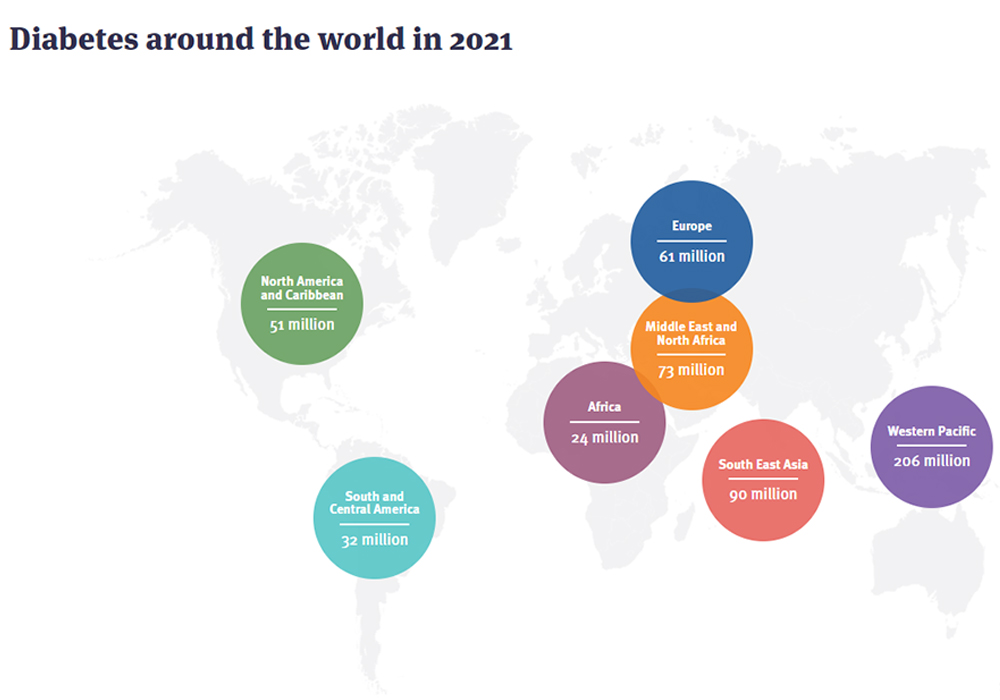Could Your Lifestyle Choices Lead to Type 2 Diabetes?

Did you know that diabetes is quickly becoming a global epidemic? The image above shows diabetes around the world in 2021 (courtesy of International Diabetes Federation). Diabetes causes disability and is one of the top causes of premature death.
In Australia, one in seven adults has diabetes, and that’s just the ones who know about it. In reality, it’s likely that one in five adults are affected.
What is even more concerning is the increase in children who are pre-diabetic or have type 2 diabetes. It’s generally accepted that lifestyle choices directly impact a person developing type 2 diabetes.
Knowing what diabetes is, and how your lifestyle choices can lead to you developing this condition is important, so you can make changes to prevent diabetes from developing.
What is diabetes?
Simply put, diabetes is a disorder where the body suffers from high levels of sugar in the blood due to a deficiency of, or a resistance to, the action of the insulin hormone. The insulin hormone is an important hormone made in the pancreas organ, which regulates the body’s blood sugars after eating and during exercise.
When you develop diabetes, you may develop the following symptoms:
- Urinate frequently
- Have increased thirst
- Suffer from increased tiredness or fatigue
- Notice sudden changes in your weight
- Have trouble healing wounds or cuts
There are two main types of diabetes - type 1 and type 2 - which, while displaying these same symptoms, have quite distinctly different causes.
Type 1 diabetes
Type 1 diabetes is due to an autoimmune, irreversible destruction of the insulin-producing beta cells of the pancreas and presents in young children through to young adulthood.
While genetics plays a role in the development of type 1 diabetes, it remains unclear what the environmental triggers are that start one’s own immune system destroying the insulin-producing beta cells of the pancreas.
Type 2 diabetes
Until the obesity epidemic of the last 30 years, type 2 diabetes was largely a disease of overweight older adults. However, it is now presenting increasingly in overweight adolescents and younger adults (under 50 years of age) especially from high-risk ethnic groups:
- Central Asians
- South Pacific Islanders
- Aboriginal and Torres Strait Islanders
- Other aboriginal native populations
Diabetes now affects over 500 million people from all nations, whether poor or wealthy, across the globe. It is highly influenced by genetic risk in families and caused by the globe’s increasingly unhealthy 21st century sedentary lifestyles with high dietary intake of highly ultraprocessed foods.
Type 2 diabetes is a condition where the body becomes resistant to the insulin it develops. While there are many new medications that patients with type 2 diabetes can use to help control their blood sugar levels, lifestyle choices play a significant role in preventing, potentially reversing and keeping type 2 diabetes under good control.
Keeping type 2 diabetes under control can prevent:
- Micro and macro vascular complications such as impaired vision and blindness from retinopathy
- Kidney and heart disease
- Peripheral vascular and neural disease.
Type 2 diabetes is totally preventable in almost all cases, and reversible in its early stages if you make some positive changes to your lifestyle.
What are the risk factors for type 2 diabetes?
As with any illness, there are some risk factors that increase the chances of you or your child developing type 2 diabetes. Some of these are:
- Being overweight – the extra fat directly contributes to insulin resistance
- Gender – girls are more prone than boys to develop type 2 diabetes
- Family history – if someone in your family has it, you or your children are more likely to also develop it
- Inactivity – leading an inactive or sedentary lifestyle can increase risk of diabetes
- Age
What can you do to prevent type 2 diabetes?
While some of the risk factors for type 2 diabetes can’t be changed, such as your family history, thankfully the most important ones can. You can control your lifestyle choices and make changes that can help prevent you or your children from developing type 2 diabetes.
Exercise helps to reduce the risk of developing diabetes
Being overweight or obese significantly increases your chances of developing type 2 diabetes . Exercising every day is an essential part of not only losing extra fat, but also maintaining a healthy body weight. People with less body fat utilise the insulin they naturally produce more effectively, and so their risk of developing diabetes is noticeably reduced.
A good rule of thumb is that children should be moving for at least 60 minutes a day, and adults at least 20. This may sound like a lot, but exercising doesn’t need to be a strenuous event. It should be enjoyable, and ideally work in with your current lifestyle. Getting moving with your child could be as simple as:
- Doing household chores together, like mowing the lawn or hanging the washing out
- Walking to the shops to get milk
- Vacuuming the house
- Playing fetch with your dog
Making small changes regularly, soon add up to big results. So, if moving for 60 minutes seems like a big jump from what you do now, start slowly with 10-15 minutes a day and gradually increase it. Small, achievable lifestyle changes are far more likely to be sustainable in the long run.
What you eat has a significant impact on diabetes

If you are ready to make changes to your lifestyle choices and habits to help prevent diabetes, then looking at your diet is essential. You are what you eat, so even making small adjustments to your diet can have a significant impact to your overall health.
Some of the most significant changes you can make are:
- Fill your plate with colour – you want your plate to look like a rainbow at every meal. Colourful foods are much more nutrient dense so swap out your fries for a side salad
- Eat breakfast every day – how you start your day is a reflection on how your day will continue, so invest well in this meal to set yourself up for success
- Eat as a family – when your children see you enjoying colourful, nutritious meals, they are more likely to copy you and make healthy food choices also
- Swap out your processed snacks – swap your muesli bar for a piece of fruit and some nuts; you’ll feel fuller for longer and your blood sugar levels will remain more stable
- Eat smaller portions – serving your meals on a smaller plate is an easy way to achieve this without feeling like you’re going without
- Drop the soft drinks, even the diet ones – they have no nutritional value. Have some water instead. Removing just one soft drink a day from your diet can significantly reduce your risk of developing diabetes.
How much sleep should children and adults be getting?
Sleep is like the Swiss army knife of health. When you’re getting plenty of it, there is vitality and health, and when you’re sleep deprived, there is illness and disease.
Sleep deprivation has been linked to many common health problems including:
- Depression and anxiety
- Cancer
- Obesity and diabetes
- Heart and blood pressure issues
- Memory impairment
Sleep plays a critical role in keeping your body healthy. Often, we take it for granted when we’re getting enough and it’s not until we’re deprived of it that we think about it. So how much do you need?
As a rough guide:
- Pre-schoolers should be aiming for 10–13 hours’ sleep a night
- Primary school children should be getting about 10 hours
- Older children at least nine hours
- Adults should aim for eight hours a night
Keeping a journal of the time you and your children go to bed, get to sleep, and wake up in the morning is a good way of checking in on your sleep health.
Need help to make better lifestyle choices?
November 14th is World Diabetes Day. If you’re worried about your lifestyle choices and the impact they have on your family and your health, we’re here to help.
At Childhood Obesity Prevention, we understand that sometimes you and your children may need extra support to make sustainable changes. We have a range of support options available to suit your family, from self-guiding your journey to healthier eating habits with our book Ride to Life, through to personal consultations.

